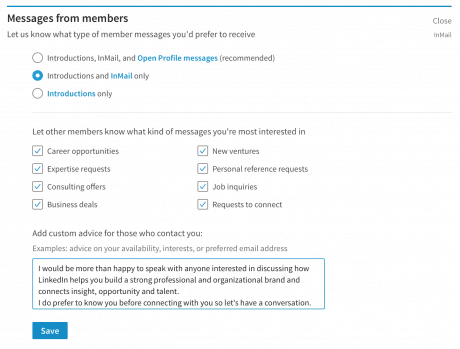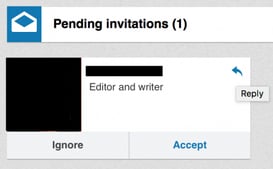When this post was originally published in June 2014, we received such a great response. Since then, it has been shared and referenced over and over again. For those that haven’t read it yet, we’d thought we’d share it again; a great reminder for business development professionals and CEOs. Enjoy!
This week I had the opportunity to host a LinkedIn workshop for 17 CEOs. These CEOs lead companies in a wide range of industries and stages of maturity and they range in age from early 40s on up. A few shared their thoughts on social media and LinkedIn. “Why do I get so many random invitations?” someone asked. I think everyone nodded in agreement.
They don’t really like those constant, random invitations. Actually, there was no one who liked them. CEOs get more than their share of invitations, no doubt.
“By virtue of being the CEO, people want to know you and connect with you. You make the decisions and you authorize purchases,” I answered. It’s both reality and the truth. People may not connect with the CEO because they actually want to know you. It comes with the title, period.
Other things I heard throughout the morning included:
“Uggghhh, how do we work around that? I don’t want to be a jerk but I get too many invitations from random salespeople to respond to.”
“Is it better to just delete them or should I answer them”
“They only want something from me. They’re just trying to sell me something. Don’t they know I already know a dozen financial planners, insurance people, printers, IT providers? I don’t want them in my network trolling around.”
There’s truth in each of those statements. I get it. Let’s take a look at what’s happening in a typical invitation exchange.
For business development, salespeople (and everyone who wants to talk with CEOs)
Your job is to get in front of decision makers. Period. And now, you use LinkedIn. Good work. But think about your sales process. You have a quota, you have a list of prospects or customers and you need to make a certain number of calls, appointments and actual meetings in a week and month. You are diligent, often aggressive (that’s part of your DNA and job description if you are a hunter) and you reach out via every means possible.
If you were the CEO would you take your call, respond to your email, accept your LinkedIn invitation?
Be honest. Have you provided enough reason, value, or earned enough trust to warrant his or her response? Do you have enough status, power or known celebrity to warrant a CEO of a company to want to talk with you? If you are honest, probably not. Stop trolling and start putting some effort into to working on their behalf. The best business development process is well crafted, intentional and thoughtful. It’s personalized through good research, an introduction, a great referral, and a proof-based value proposition.
Consider it from the CEO’s perspective. They are smart people and have trusted go-to advisors. They probably have insurance, financial advice, networked printers, and most everything else it takes to run a business. Once again why should they connect with you? Colleen Stanley‘s post, Are You Thinking Like a CEO? goes right to this point. CEOs know people, know how to reach out to those they want to do business with and are careful about inviting new people in without a reference or referral. Initially, at least, you represent a learning curve, change, and risk.
Many of today’s CEOs are not comfortable online. They did not necessarily come of age in a collaborative, open networking system. They are concerned about privacy, breaches, and the list goes on. Younger CEOs are far more likely to be open to connecting. Know your audience.
Everyone says to start at the top. Sometimes it works but often it doesn’t. Consider starting where you have a champion, a well-respected champion.
Here are three ways to earn trust and make the most of your current network.
1. Ask for referrals, you may or may not receive them but at least you asked. Consider who you are asking and why they would refer you in. Have you treated them well?
2. Be good at what you do, do more than what was expected, and create a reputation that begins to precede you (can you find a market niche, for example). You will receive some good referrals.
3. Be so good, you receive referrals without asking for them. It’s a bit like the Holy Grail, right? This is where you have earned the trust in an area, geography, market.
For CEOs
You are the people that business development, salespeople, consultants, and job seekers need to reach. You can’t possibly talk to everyone nor should you. You need to be discerning, no doubt, and you need to manage those parameters. But you may also need help, advice, new solutions, or products, and these business development/salespeople, consultants and job seekers have what you may need. You may also need to replace a supplier for poor performance, inferior products and services, etc., or you may need to transition into systems, solutions and products that did not exist a few years ago (CRM, marketing automation, content management system, etc.) and you need to vet your options.
Business development and other folks are here to bridge the gap. Find the good ones and you are golden. Having a vetting process is important. One of the major reasons business development folks push to get in front of you is obvious. You are the final authority, you sign the checks.
If you don’t understand and endorse the solution, it will most likely fail and that is a reflection on you and your team, although the fault usually falls on the product or service being delivered.You need to buy in, support and be an ambassador for the rollouts in your organization.
Even with that said, you should want to better manage the flow of people reaching out to you on LinkedIn. If so, read on. There are ways to manage how you show up and whether people can reach you.
CEOs Change Your Settings
If you are on LinkedIn change your Settings (upper right corner under your photo or silhouette). Click on Communications >> Basic >> Messages from members.

Choose what you are comfortable with related to messages, opportunities and advice. The content you add to the advice area will show up on your Profile. I really like this setting because if you actually read my Profile and know how I discern invitations, you hopefully won’t think I’m a jerk if I don’t accept or respond.

Choose who can send you invitations. If you prefer to keep those invitations limited, choose from two or three.

Additionally, hover over the person icon in the top right corner of your profile. Click “See All” across from “Pending Invitations.” Rather than accepting the invitation, click on the reply arrow in the top right (without accepting the invitation) and send them a quick message saying you prefer to know the people you connect with and ask why you should connect or suggest a conversation.

I really like this option and use it often. Remember, it’s important that your network means something and is more than an address book.
Another tip? Consider what you put in your headline area. Don’t put your title. Add keywords related to your industry and focus and let your title rest in the experience area.
I recognize the plight of business development and sales, as well as the plea of CEOs. Everyone needs to figure this out especially when it comes to LinkedIn. Professionals on LinkedIn should want to leverage their personal and professional connections and the greater network to further business goals.
If you missed my earlier post, Why CEOs Need to be on LinkedIn, check it out. Nothing has changed, CEOs need to be there as the leader and the best development officer and spokesperson for the organization. Don’t be dismissive, be open minded to the opportunities LinkedIn affords you, your colleagues and organization.
Here are some additional resources in case none of this passes your sniff test.
Online Marketing and Social Media Statistics
How to Help Your CEO Shine on the Social Scene
The Social CEO: Executives Tell All
And, hey, to all sales, business development people, consultants and job seekers, act like an owner, think like an owner, and reach out like an owner. Make it count, be valuable and memorable in the best possible way.
This post was originally published on Intero Advisory’s website in September 2016. Please note that LinkedIn is constantly changing. While it’s current now it may not be in the coming weeks or months.


